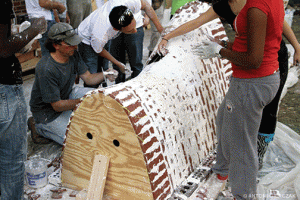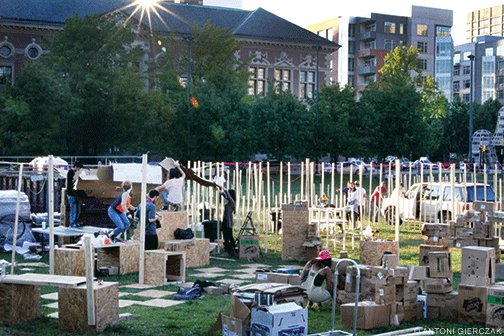How many Penn students and faculty members does it take to transform 1,300 plywood stakes, a pallet’s worth of cardboard bound for the recycling bin, and dozens of rolls of white gaffer’s tape into a makeshift village?
Judging by “Informal Armatures,” a pop-up settlement that appeared suddenly on Hill Field one sunny weekend in September, the number is about 60. Designed to provoke, inspire, and teach lessons about town planning and affordable housing—especially in developing nations, where ever-increasing numbers of people reside in “informal settlements”—the project was the vision of David Gouverneur, an associate professor of landscape architecture.
Built primarily by students in his “Landscape Urbanism and the Making of Communities” studio, the installation was the largest and most dramatic piece of the inaugural IDEA (Interdisciplinary Design Engagement Activities) Days Festival, an attempt by the School of Design to foster collaboration among the school’s departments, as well as with partners from across the city.
Fast, cheap, and somewhat out of control served as the weekend’s watchwords. The erectors of the encampment, for example, used about $2,000 worth of materials, cobbled together from the aisles of Home Depot, to mark boundaries of public and private space. They laid row upon row of 8-foot-long stakes in just two days, ending up with a field that called to mind the military cemeteries at Omaha Beach in Normandy. Within that matrix they constructed teepee-shaped “houses” out of kraft paper, and outlined plots for community gardens, a marketplace, piazzas, recreation areas, greenhouses (suggested by crumpled plastic wrap), and even a meditation area.
“The materials don’t matter,” Gouverneur said. “They’re placeholders, symbols, really, to demonstrate that with very simple design moves and at minimum cost, you can create sustainable, affordable communities for low-income dwellers.”
Within the next two decades, he added, experts predict that some two billion people will live in “self-constructed cities” such as the favelas that dot the hillsides of Brazil.
“This a major concern,” Gouverneur said. “While these informal areas are dynamic, transform quickly, offer strong social ties, and are in a lot of ways models of mixed-use planning, they also lack accessibility, provide no public space, and are missing basic services like electricity, safety, and sanitation.”
Other IDEA projects included a PARK(ing) Day exhibit on Walnut Street—part of a larger national initiative wherein people and institutions take over metered parking spaces and replace them with hand-crafted miniature parks and seating areas.
 Another brought seniors from Philadelphia’s Charter High School for Architecture & Design to a sliver of lawn alongside 34th Street, adjacent to Meyerson Hall, where they worked with grad students to build tiny Guastavino-style arches—the kind that distinguish Grand Central Station in New York.
Another brought seniors from Philadelphia’s Charter High School for Architecture & Design to a sliver of lawn alongside 34th Street, adjacent to Meyerson Hall, where they worked with grad students to build tiny Guastavino-style arches—the kind that distinguish Grand Central Station in New York.
“It’s really cool watching them come to life before your eyes,” said 18-year-old Chris Roman, mixing mortar and handing it down the line to the appointed masons.
“My students proposed the idea of a meditation garden,” said Sarah Rottenberg, associate director of the Integrated Product Design program. “I loved it because I thought it would force them to explore the challenges inherent in designing an experience which they can control parts of, but not the whole. Understanding the boundaries of control and how to encourage people to engage are important issues [for any designer].”
Like most of the other installations in the great grid of the Informal Armatures area, it was more like a rough sketch than a fully built vision. But still, a handful of colorful chair pads, a hastily erected shade structure, and a few pots of mums resting on a handful of stones proved sufficient to draw passersby for an impromptu Friday afternoon yoga class.
—JoAnn Greco


